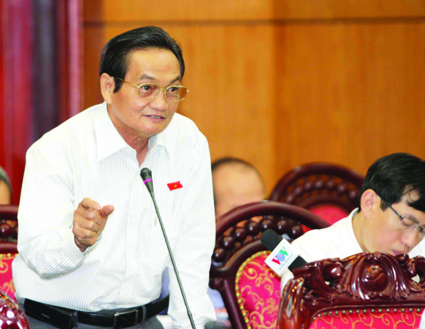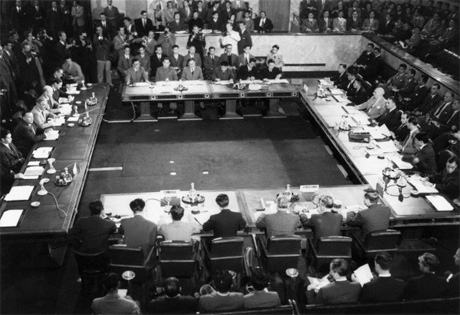Dr. Tran Du Lich
Member of the National Assembly’s Economic Committee
Placing public investment restructuring within the overall economic restructuring and associating it with the objectives of economic restructuring
Though the economic restructuring in the 2011-2015 period focuses on three contents: public investment, state enterprises and banking system, these three contents should take into account the objectives of overall economic restructuring associated with the change of the economic growth model in the spirit of Resolution No. 10/2011/QH13 of the National Assembly, which was implemented by the Government under Prime Minister Decision No. 339/TTg-QD of February 19, 2013. The reason is that the ultimate aim of the restructuring of these three areas is to boost the overall economic restructuring in association with the change of the growth model and increase of the competitiveness of the economy. The resolution of the third plenum of the Party Central Committee (the XIth Congress) states: “...It is necessary to concentrate on three most important areas: restructuring of investment, with a focus on public investment; restructuring of the financial market, with a focus on restructuring of commercial banks and credit institutions; restructuring of state enterprises, with a focus on state economic groups and corporations.” So, even the public investment must be placed within the broader context of restructuring of social investment, not just limited to the public sector.
 |
| NA Deputy Tran Du Lich of Ho Chi Minh City gives comments on the draft revised Investment Law to be put up for discussion at the NA’s eighth session__Photo: Phuong Hoa/VNA |
However, the guideline on overall economic restructuring associated with the change of the growth model has so far not yet been materialized; there have been no specific policies and solutions to lead enterprises into the restructuring process in agriculture or the shift from processing industry to manufacturing industry; change of the perception of the structure of the local economy, etc.
The public investment restructuring under Prime Minister Directive 1792/CT- TTG of October 15, 2011, has not yet settled the problem to the roots. It is necessary to clearly point out that the deep-rooted cause of waste and inefficiency of public investment is the investment decentralization mechanism that leaves it entirely to localities while the central administration cannot control the central budget allocations to localities (for example, the Ministry of Education and Training can control only 2.8% of the total investment in this sector). It should be clearly explained why many poverty-stricken localities with small budgets have still given priority to the construction of monumental state offices while they have had no money for investment in essential welfare facilities for local inhabitants.
Strong policies should be worked out to boost the process of overall economic restructuring, especially three fields: restructuring of agriculture; shift from processing industry to manufacturing industry; and development of regional economy in replacement of local economic structure. These issues are related to planning of agricultural land, including rice-growing land; policies on use of agricultural and forestry farm land; construction of agricultural-industrial production strongholds; financial policies for localities that maintain rice land areas for food security; policies on development of supporting industries; policies on localization of products, etc.
Clearly determining the scope of public investment and public investment function with a view to orientating the public investment restructuring (investment by state enterprises is in essence public investment)
Under the law on public debt management, public debts do not cover state enterprises’ debts, except for government-guaranteed loans. However, the scope of public debts differs from the scope of public investment. Public investment means the State’s investment to perform the State’s socio-economic tasks. The State’s investment is made with such sources of funds as taxes and charges; state credit; public bonds; via state agencies, state-run non-business units and state enterprises. A large number of state enterprises make investment to perform their function of supplying public goods and services; economic development; investment in key fields of the economy where the private sector does not want or is not strong enough to make investment. So, the scope of public investment is wider than that of public debts under current law.
In the 2001- 2005, public investment accounted for 53% of the total social investment, of which the investment by state enterprises made up 14.9%. In the 2006-2010 period, the corresponding figures were 42.7% and 10.1%; and in 2013, they were 29.1% and 8.4%. The positive effect of public investment in the recent years was that it stimulated the rise of total social investment, but its proportion to the total social investment gradually decreased. This is one of the necessary criteria for the distribution and assessment of public investment.
Associating public investment restructuring with the policy of proactive budget overspending for investment (the positive public financial policy)
In many years to come, Vietnam still has to implement the policy of proactive budget overspending by borrowing loans for investment in the development of technical and social infrastructures and acceleration of the process of national industrialization. That is a positive public finance policy under the conditions that the economic accumulation remains low and the domestic savings fail to meet the sustainable development investment demands. However, this policy must be accompanied with very strict conditions such as a clear strategy on the Government’s debts and national debts; conditions to guarantee investment efficiency; the capability of paying annual debts in local and foreign currencies; compliance with the principles of opportunity cost and synchronism in investment; thrifty state expenditures; transparent investment capital distribution mechanism; and strict investment capital flow supervision mechanism. However, the overspending of the state budget in the past years has not yet strictly complies with the above-listed conditions as well as other conditions. As a result, the positive public finance policy has become a negative factor, threatening to destabilize the national finance.
Should investment continue to be made as in recent years, it will consequently increase risks for the financial system and public debts and contribute to causing macro instability (inflation, trade deficit...).
 |
| The newly built Institute of Malariology, Parasitology and Entomology of Quy Nhon__Photo: Quoc Dung/VNA |
Over the past years, especially since the beginning of its term, the 12th National Assembly had repeatedly raised the budget deficit level and issued government bonds (not included in over-expenditure) for allocation to various sectors and localities to invest in the sectors permitted by the National Assembly. However, no quantitative assessment of the efficacy of projects and works financed by this funding source has been made yet. Though the Government has set criteria for allocation, specific evaluation of implementation results has not been made yet. Reality has showed that sectors and localities put forth numerous projects, while the funding sources are limited (when the Government issued Directive 1792, only 38% of the projects proposed by localities and ministries or sectors could have access to funds). Hence, those localities or sectors that “sought” to early complete the procedures would have their projects approved and funds disbursed early; those that were slow in doing so would see their projects shelved. This situation has consequently broken the order of priority and synchronism of investment, with capital “scattered” everywhere, the interests paid by the state budget, but projects left untouched for a long time. Our country faces numerous difficulties in all aspects, all fields and all geographical areas, which all need investment. Of course, there must be priority areas and priority sectors, but priority must be given under certain conditions. For instance, prioritized investment in rural, mountainous or border areas should be made through national programs with the support of the central government throughout the process of implementation, from formulation of projects to performance assessment, rather than leaving localities a blank check according to the current decentralization mechanism. Investment in vocational training must take into account the “software” factors, namely the teaching staff, students and post-training employment, not merely the construction of schools and classrooms; the same for the health service. Investment funds should be allocated not simply to sectors or geographical areas but specifically to each project, taking into account investment schedule and methods in order to balance the funding sources under the motto that any project implemented must be definitely put to use and the synchronism and spillover effect of each project must be ensured. We still lack the mechanism of accountability for inefficient investment. Even with the recently passed Public Investment Law, it is still hard to determine the accountability of agencies that decide on inefficient investment policies. The public investment has been dealt with only at its top but not at its roots.
Associating public investment restructuring with the public debt safety goal
Vietnam’s current public debt structure (according to the definition of public debt in the Law on Public Debt Management) is exerting higher and higher pressure on the annual debt payment obligation, which surpasses the central budget revenues, thus leading to greater and greater loans for debt reschedule. For example, in 2014, the Government’s payable debts amount to VND 208,883 billion while the state budget revenues reserved for debt payment only reach VND 118,750 billion, with the deficit of VND 90,000 billion to be borrowed. This figure will gradually rise in subsequent years, becoming a worrisome risk of public debts.
For long, when speaking of public debt safety we have often laid stress on the ratio of public debts to GDP, not on the more important element, namely the total debt amount to be paid annually against the total state budget revenue. Whether the public debt crisis occurs or not greatly depends on this ratio. In 2013, this ratio of Vietnam was 22.3%, which will surely rise quickly in the coming years. When the above ratio exceeds 25%, the alarming state begins and if it exceeds 30%, unsafety will occur.
If a public finance is recorded with overspending for investment for 10 consecutive years, without resulting in an effective economy capable of creating a higher value (relatively calculated) manifest in a surplus used for “ expanded reproduction” (based on the difference between revenues and regular expenditures plus payment of due debts), the unsafety danger actually occurs. More specifically, if 2006 began with overspending with loans in various forms for investment when there was not yet any surplus between revenues and regular expenditures, a budget surplus for investment must be generated by 2016. With such calculation, I propose an analysis and assessment of the loan borrowing situation over the past 10 years and the development of a public finance strategy for 10 years to come; only then can we have grounds for evaluation of the safety. Without long-term forecasts, when unsafety occurs, the state or enterprises cannot act against it in time. Such status is called “default.”
Clearly defining the nature of central and local budgets and the accountability of each type of budget
Under the Public Debt Management Law and the State Budget Law, the local administrations’ debts are in essence the State’s debts in such an integrated state budget of Vietnam (the central and local budgets are jointly integrated into the state budget). Under this system, local administrations are not autonomous in borrowing loans; hence, so far, the ratio of local administrations’ debts to the public debts has been small, which was recorded at 0.6% in 2010 and 1.6% in 2013, of which about half were municipal bonds while the rest are loans from the State Treasury and Vietnam Development Bank. As local administrations have no budgetary autonomy, their debts are in essence debts of the Government which at last is obliged to pay such debts. The creation of a mechanism for local administrations to enjoy autonomy in borrowing loans and a debt control mechanism depends on the revision of the State Budget Law and the formulation of the Local Administration Law toward separating the local budget from the national budget (belonging to the central administration) and abolishing the integrated budget mechanism.
At present, many localities long for a mechanism of autonomy in borrowing loans for investment under the principle of self-borrowing and self-payment, particularly those with a budget revenue surplus contributed to the central budget. Nevertheless, the autonomy mechanism cannot be applied unless the national budget and local budget are separated. This is the key matter in revising the State Budget Law.
First of all, it is necessary to have a proper understanding of the local budget. At present, the local budget is understood as the budget revenue and expenditure decentralized to a locality. This has led to the situation that when a locality, as provided by law, earns VND 1,000 billion but spends VND 5,000 billion, its local budget will be VND 5,000 billion; but another locality earns VND 50,000 billion but can only spend VND 20,000, its local budget will be VND 20,000 billion. So, the local budget is understood to be the money amount spent annually, irrespective of whether such money amount is created by the locality or allocated by the central government. The question is that the local budget should be construed to cover budget revenues created in a locality (which belong to the locality under law) which are used to cover the spending demands of the locality. If such revenues are not enough to cover the expenditures, the central budget will provide subsidies which, big or small, are, in essence not the local budget. Localities should have the autonomy only over their own revenues, but not over the central government’s subsidies. If an amount of VND 100 belongs to the local revenue, it would remain to be decided by the local administration (the People’s Council). If an amount of only VND 1 is provided by the central government as subsidy, such expenditure must still be decided and supervised by the National Assembly. The decision on and supervision of expenditures from these two sources are totally different and carried out by local administrations under two different mechanisms: autonomy mechanism and authorization mechanism. These two mechanisms cannot be combined into one called decentralization. This has primarily led to constraints in the current budget management such as ask-give mechanism; thinned-out inefficient investment; lack of accountability; lack of motive force for tapping budget resources; cover-up of revenue sources; planned revenue lower than actual revenue.
As public investment is the core of the public finance policy, it must be settled from the root. The current State Budget Law must be substantially renewed first, paving way for the revision of the Public Debt Management Law and other relevant ones. The National Assembly must renew the process of formulating and approving annual budgets. If the annual budget continues to be adopted by a single resolution, it must be implemented through two sessions of the National Assembly, with the mid-year session discussing and deciding on budget allocation guidelines and expenditure orientation and the year-end session adopting specific figures. The role of the Finance and Budget Committee of the National Assembly in the estimation and appraisal of budgets and supervision of actual expenditures must be heightened. The local administrations’ autonomy over local budgets must be clearly defined and their use of central budget subsidies must comply with strict rules. The Government should not provide guaranty for local administrations to issue bonds and should issue warnings about their debts.
The public administration must be strongly renewed toward clearly defining the responsibilities of the administrations at each level, avoiding overlap of their functions and tasks and raising the local administrations’ autonomy and accountability within the scope of their decentralized powers. The mechanism of decentralization by leaving the whole work to localities as at present must be abolished and replaced by two mechanisms: decentralization and authorization between the central and local administrations. These matters are related to the draft laws being scrutinized by the National Assembly: the Law on Organization of Local Administrations; the Law on Organization of the Government; and the State Budget Law. These laws are of decisive significance to the reform of public administration and public finance.
In short, the public investment restructuring process initiated in the end of 2011 has yielded certain results, of which the most prominent point is that sectors and localities must select priorities under the condition of imbalance between investment demand and funding sources. Yet, the reduction of investment and adjustment of investment projects,... are only “reluctant” solutions. The question now is to address the roots of the problems in our public finance and public administration.-








